EQUIPMENT TEST REPORTS: Hirsch-Houck Laboratory test results on the: JVC JR-S600 AM/FM stereo receiver, Marantz Model 1250 integrated stereo amplifier, KLH Model 354 speaker system, and Micro Seiki DDX-1000 turntable and MA-505 tonearm.
JVC JR-S600 AM/FM Stereo Receiver
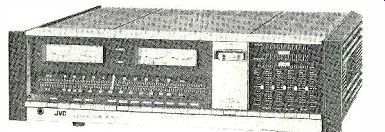
HE most powerful receiver in the current T JVC line is the JR-S600, rated to deliver 110 watts per channel to 8 -ohm loads between 20 and 20,000 Hz with no more than 0.1 per cent total harmonic distortion (THD). Backing up this power is a preamplifier fitted with the JVC SEA (Sound Effect Amplifier) graphic -equalizer system instead of conventional tone controls.
The FM/AM tuner section of the JR-S600 makes liberal use of integrated circuits, including a phase-locked -loop (PLL) multiplex demodulator, a quadrature detector for FM, and an AM tuner employing a single IC. The FM section has a built-in "noise-reduction" circuit, apparently a form of JVC's ANRS system, for decoding Dolbyized FM signals.
The JR-S600 features the radically different styling of the new JVC line. The front panel is finished for the most part in black, with aluminum accents. The dial scales, slanted slightly backward, are near the bottom of the panel.
Above them are two pairs of meters that are lit in blue when the receiver is on. Two are conventional tuning meters, reading relative signal strength for AM and FM plus FM channel-center tuning. The other pair, calibrated in watts delivered to 8-ohm loads, monitors the amplifier outputs. Their logarithmic scales cover a range from well under 0.25 to over 110 watts. Illuminated legends appear in blue be tween the meter groups to indicate FM STEREO, reception and when the noise-reducing circuit (NR) is switched on.
The sole occupant of an aluminum panel section to the right of the dial area is a horizontal tuning control-actually the rim of a flywheel drive protruding slightly from the panel (there is a second flywheel within the receiver). The right section of the panel is devoted to the five vertical slider controls for the SEA circuit, which vary the response over a nominal -±10-dB range at center frequencies of 40, 250, 1,000, 5,000, and 15,000 Hz.
Above them is a slider balance control with a center detent and a slider volume control, both oriented horizontally.
The other operating controls form a row of aluminum -finish pushbuttons across the full width of the panel just below the dial and SEA area. They include power and speaker switches (the latter for separate control of two pairs of speakers) and program selectors for AM, FM, PHONO 1, PHONO 2, and AUX sources. There are separate monitor buttons for two tape decks and a DUBBING button that cross -connects the machines for copying a tape from either one to the other.
Below the tuning wheel, the continuing row of pushbuttons includes the FM MUTING switch, FM NR switch, and the MONO switch.
The buttons below the SEA controls switch in the LOUDNESS compensation and the LOW and HIGH filters; the SEA DEFEAT bypasses the entire SEA circuit. A stereo headphone jack is located just below the power switch at the lower left of the panel.
On the rear apron of the JR-S600, in addition to the various signal inputs and outputs, are antenna terminals for 75- and 300-ohm FM antennas and a wire AM antenna, as well as the pivoted AM ferrite-rod antenna. There are separate preamplifier outputs and main -
amplifier inputs, joined by jumper links, and an FM detector output for possible use with a future four -channel discrete FM adapter. The TAPE 2 connectors are duplicated by a DIN socket. The insulated pushbutton speaker connectors require only that the stripped end of the wire be inserted in a small hole, where it is clamped when the button is released. One of the two a.c. outlets is switched.
The JVC JR-S600, as one would expect in a unit with its power rating, is rather large and heavy. It is 22 inches wide, 17 inches deep, and 63/4 inches high; it weighs about 41 pounds. The side panels of the receiver are molded of ribbed plastic, styled to resemble metal heat -sink fins. However, their principal non-cosmetic function is to serve as handles for lifting the receiver, and they are very well suited to that purpose. Price: $750.
Laboratory Measurements. Following the standard preconditioning period (during which the top of the cabinet became quite hot), the amplifier delivered 128 watts per channel to 8 -ohm loads at the clipping point.
The 4-ohm output was 173 watts, and at 16 ohms it was 85 watts. At 1,000 Hz, the THD was below our measurement limit of 0.003 per cent until the output exceeded 10 watts. It measured 0.0056 per cent at 20 watts, 0.025 per cent at 120 watts, and 0.1 per cent at 130 watts (approximately the clipping point). The intermodulation distortion (IM) was under 0.02 percent up to about 15 watts, reaching ...
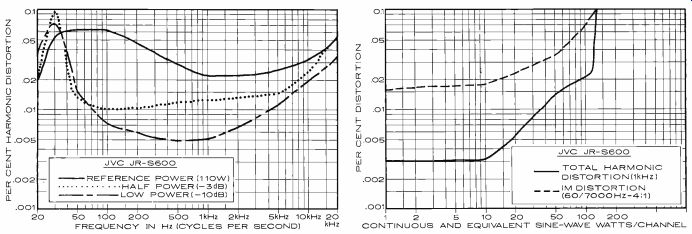
-------- FREQUENCY IN Hz (CYCLES PER SECOND kH CONTINUOUS AND
EQUIVALENT SINE -WAVE WATTS/CHANNEL
... 0.05 percent at 75 watts and 0.1 percent at 125 watts. The IM rose somewhat at very low power levels to a maximum of 0.45 per cent at 10 milliwatts.
At the rated 110 watts output, the THD was about 0.06 percent below 100 and at 20,000 Hz, but it decreased to about 0.025 per cent between 500 and 3,000 Hz. At lower power outputs the distortion was substantially lower, typically between 0.005 and 0.015 percent.
The SEA tone controls provided the versatility one would expect from a five -band graphic equalizer. Obviously they can create a greater variety of useful frequency-response curves than is practicable with more conventional tone controls, and they have the further advantage that the knob positions out line the approximate frequency-response curve.
The switched filters had marginally adequate 6-dB -per-octave slopes, with their -3-dB frequencies being approximately 100 and 4,000 Hz. The loudness compensation boost ed both low and high frequencies at low set tings of the volume control. The extended RIAA phono equalization was accurate within ±1 dB from 20 to 20,000 Hz, and it was within ±0.5 dB over the defined range of 50 to 15,000 Hz. There was a slight interaction with the phono-cartridge inductance, causing an in crease in output at frequencies above 10,000 Hz. The effect was slight, however, amounting to about 1.5 dB at 15,000 Hz and 4 dB at 20,000 Hz.
The audio sensitivity for a 10 -watt reference output was 62 millivolts (mV) through the Aux inputs, with a very low -77-dB noise level. The phono sensitivity was quite high, 0.62 mV, yet the noise was a low -74 dB and the phono preamplifier overloaded at a very high 280-mV input.
The FM tuner section had a usable sensitivity (in mono) of 11 dBf or 2 microvolts (uV).
The stereo sensitivity was set by the switching threshold at 27 dBf (12 uV). Quieting sensitivity (50 dB) in mono was 13 dBf (2.5 µV) with 1 percent THD. In stereo, it was 36 dBf (35 uV) with 0.37 percent THD. The ultimate SIN at 65 dBf (1,000 uV) input was 68 dB in mono and 67 dB in stereo. The respective distortions at that level were 0.06 and 0.085 per cent. The stereo distortion with 100 percent out -of -phase (L-R) modulation was 0.11 percent at 100 Hz, 0.036 per cent at 1,000 Hz, and 0.079 per cent at 6,000 Hz.
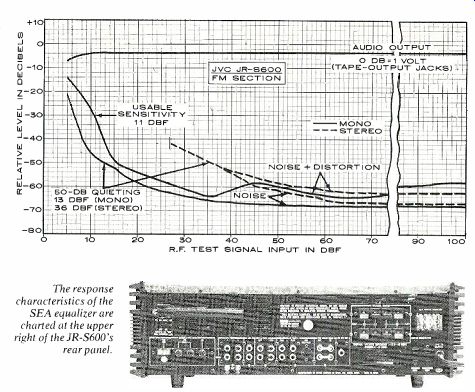
------ The response characteristics of the SEA equalizer are charted
at the upper right of the JR-S600's rear panel.
The FM frequency response was flat within ±0.5 dB from 30 to 12,000 Hz and was down 2 dB at 15,000 Hz. The phase-locked-loop multiplex circuit showed its effectiveness in the outstanding stereo channel separation, which exceeded 40 dB from 40 to 3,000 Hz and was at least 30 dB from 30 to 15,000 Hz. The AM frequency response was down 6 dB at 75 and 3,800 Hz.
The other FM-tuner characteristics were also very good. The capture ratio was 1.36 dB at 65 dBf (1.33 dB at 45 dBf), with 65 dB of AM suppression (although the latter de creased to 52 dB at a 45-dBf input). The image rejection at 98 MHz was 83 dB. Alternate -channel selectivity was a very good 88 dB, and adjacent -channel selectivity was 6.5 dB.
The muting threshold was the same as the stereo-switching threshold -27 dBf (12 µV).
Pilot carrier leakage at 19 kHz was a low -75 dB, and hum was -69 dB. The FM muting worked well, but we often heard a "thump" 90 100 when tuning on or off a station, which might be hazardous to small light -duty speakers if the volume were set too high.
In our tests, JVC's FM noise reduction worked about as well as the conventional Dolby FM decoding circuits, meaning that it reduced but did not eliminate FM noise.
Comment. In its basic operating qualities, the JVC JR-S600 leaves little to be desired. It has an excellent FM tuner, an audio amplifier whose power output and distortion characteristics rival or exceed those of many fine separate amplifiers, and a "tone control" system whose versatility could be exceeded only by a much more complex octave -band equalizer.
Add to these qualities an outstandingly quiet audio section and one of the highest phono overload capabilities in the business, and the result is clearly one of the handful of top ranking receivers on the market.
Micro Seiki DDX-1000 Turntable and MA-505 Tone-Arm
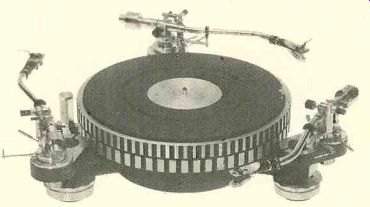
THE Micro Seiki DDX-1000 turntable is a high -quality, two -speed, direct -drive, servo -controlled unit. Its unconventional appearance derives from the fact that, instead of being mounted on a motorboard and a wood en base, it is supported by three symmetrically placed aluminum struts emerging radially from the motor housing. The full-size (12-inch) aluminum platter, which weighs about 6 pounds, rests on the motor and hides it from view, so that the only visible parts are the three mounting supports and the platter. A neon lamp located just outside the platter's edge illuminates the two rows of raised stroboscope bars around its periphery.
Below each mounting strut is a rubber "foot" coupled to the strut through a "shock absorber" or compliant damped suspension.
A large knurled wheel adjusts the height of each foot individually over a range of about 3/4 inch for turntable leveling.
The DDX-1000 turntable connects to an external control box through a 3 1/2 -foot cable.
The box, which is about 8 1/2 x 4 x 3 inches, has a panel with four buttons and two knobs. A push-on/push-off button controls the power to the unit. A light touch on either of the two speed -selector buttons sets the platter in motion at 33 1/3 or 45 rpm and also lights a red LED near the button. Above each speed selector is its own vernier adjustment knob with a nominal range of ±6 per cent. Between them is a STOP button which turns off the mo tor but leaves a red LED glowing to show that the power is still on.
A black plastic cap, extending about an inch above each mounting strut, serves as a cover for the shock absorber and as a mounting post for a tone arm. A special arm -mounting plate is supplied with a universal cutout adaptable to most separate tone arms. (An optional arm -mounting plate is available with an elongated cutout for the SME 3009 arm.) A hole at the other end slips over the mounting post, and the plate locks firmly into position with a set screw. The mounting plate can be rotated to place the arm base from 7 1/4 to 9 1/4 inches from the turntable center, enabling stylus overhang to be set readily. Since there are three mounting posts, it is possible to install up to three tone arms simultaneously on the DDX-1000.
Micro Seiki also makes a high -quality, dynamically balanced tone arm, the Model MA-505, that we tested in conjunction with the DDX-1000. The MA -505 has an S-shaped tubular aluminum arm with a low-mass cartridge shell attached by a bayonet connector.
The arm and cartridge mass are balanced by a threaded counterweight, and vertical tracking force is applied by a spring within the arm.
The anti-skating knob, near the tracking-force adjustment, shifts the position of a wire relative to the arm axis so that the tracking-force spring exerts a component of force tending to rotate the arm toward the outside of the record. There are separate reference settings for elliptical and conical styli; once set, the anti -skating torque varies in direct proportion to the tracking -force setting. A separate lateral balance weight compensates for any tendency of the S-shaped arm to move when the turntable is tilted.
Extending from the arm base is a lever that adjusts the height of the arm assembly to match that of the turntable. Another lever operates the damped cueing mechanism, and there is an integral arm rest with a lock. A braid-covered signal cable, about 4 feet long, plugs into a socket in the base of the arm.
The DDX-1000 turntable has a "nationally advertised value" of less than $600. The MA -505 arm's "value" is less than $150.
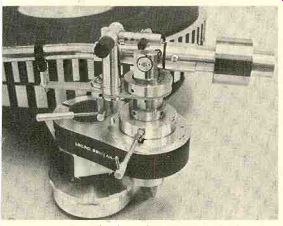
---- The stylus -force dial (the larger black knob in photo) is located
on the pivot structure above the tonearm and has a scale precisely calibrated
from 0.5 to 3 grams at intervals of 0.1 gram.
Laboratory Measurements. The Micro Seiki MA -505 arm was installed on the DDX-1000 turntable and a Shure V-15 Type III cartridge was mounted in the arm shell. The apparently complex series of setup adjustments on the arm actually made its installation simple and straightforward.
The turntable speeds were not affected measurably by line -voltage changes between 95 and 135 volts; they could be varied over a ±6 per cent range by the vernier controls. The platter reached operating speed about 2 seconds after one of the buttons was touched.
The flutter (wrms) was 0.025 per cent, the lowest figure we have measured on a turntable and probably the residual level of the DIN test record used for this measurement.
Unweighted rumble was -33 dB, and spectrum analysis showed that it was predominantly at 10 Hz with a broad distribution at lower frequencies. However, the higher -frequency rumble components dropped off rapidly, being 20 to 30 dB below the 10-Hz level at frequencies of 15 Hz or higher. Because of this, applying ARLL audibility weighting, which reduces the contribution of the lower frequencies, resulted in a reading of -63 dB, which is typical of the better direct -drive turn tables on the market.
The mounting shock absorbers isolated the turntable against vibration more effectively than most conventional turntable suspensions. However, the unit was most sensitive at about 75 Hz, a frequency easily excited by any speaker system. Though better than aver age, the acoustic-feedback isolation of the DDX-1000 was therefore, according to our test techniques, not quite as good as its unusual mounting system might suggest. On the other hand, Micro Seiki states that the very low center of gravity of the DDX-1000, combined with the design of the mounting feet, provides high resistance to lateral vibration.
Since our test technique applies only a vertical vibration component, it could not properly evaluate this characteristic.
The tone-arm tracking error was low-less than 0 4 degree per inch of radius (and usually much less). Its tracking-force calibrations were extremely accurate, with an error of less than 0.02 gram at any setting. The anti-skating compensation, like that of most arms we have tested, was slightly low when playing high-velocity test recordings. However, it was close enough to the optimum value to be considered satisfactory. The cueing system was very smooth, and the arm drifted outward only one or two groove widths during its de scent. The low -frequency resonance with the Shure cartridge was at 8 Hz, an indication that the arm mass was relatively low. The capacitance of the signal cables and arm wiring was 80 picofarads per channel, which is compatible with the requirements of CD-4 cartridges.
Comment. The measured performance of the Micro Seiki components speaks for itself. This turntable and arm clearly belong in the top ranks of record -playing components. To us, the most striking characteristic of both components (aside from styling considerations) is their ruggedness and superb finish. The turntable support structure, like most of the DDX-1000, is a heavy piece of machined aluminum, and the leveling system is simple and effective (though we wish a bubble level had been provided on one of the struts for other arms that might require leveling). In handling the turntable and its controls one has the distinct impression that it would go on working forever without loss of performance or breakdown. This is, of course, purely a "gut" reaction, but nothing in our evaluation of the turntable gave us any reason to doubt its validity.
The MA-505 arm is also a handsomely finished device, easy to set up and handle in spite of (or perhaps because of) its apparent complexity. As the instruction manual points out, the tracking -force and anti -skating set tings can be adjusted while playing a record without skipping a groove, a feat not possible on most arms. Overall, we would rank it among the best arms available.
The Micro Seiki DDX-1000 turntable and MA -505 tone arm make a hard -to -beat combination for anyone who appreciates fine workmanship as well as good performance and who has the means to indulge such appreciation. And the turntable itself will also attract those who wish to make direct comparisons of different arms and cartridges.
KLH Model 354 Speaker System
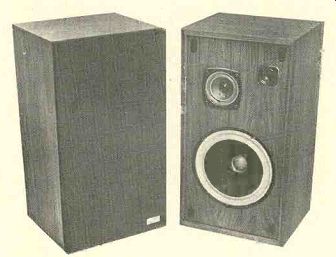
THE KLH Deluxe Dedicated loudspeaker series is headed by the Model 354, a three-way, floor -standing acoustic -suspension system. A 12-inch woofer is teamed with a 4 1/2 -inch mid -range driver and a 2 1/4-inch cone tweeter. The middle- and high-frequency drivers have a pair of three -position level switches (in the rear of the cabinet) that pro vide a slight decrease or increase of output in their respective frequency ranges relative to the normal or "flat" response.
According to KLH, the Model 354 is some what more efficient than has been the rule for other acoustic -suspension speakers of this type. A minimum amplifier rating of 25 watts per channel is recommended, but the speaker can be used safely with amplifiers capable of delivering up to 175 watts per channel.
The cabinet of the KLH Model 354 is constructed of high -density particle board finished with a walnut wood veneer. The speaker mounting board is normally concealed by a black fabric grille. Removing the grille reveals that the front of the speaker is finished in walnut like its other surfaces, with four black "Hedlock" grille fasteners in the corners to secure the grille.
The KLH Model 354 is 26 inches high, 14 inches wide, and 12 1/4 inches deep; it weighs slightly under 50 pounds. An optional walnut -finish pedestal ($25 per pair) raises the cabinet three inches from the floor. The Model 354, like the other KLH speakers, is covered by a five-year warranty including parts and labor. Price: $250.
Laboratory Measurements. Our frequency-response measurements were made with the tweeter and mid-range level switches in their center, or flat, positions. Combining the curves obtained from a quasi-reverberant field measurement at frequencies above 300 Hz with a closely miked measurement at lower frequencies, we obtained a frequency -response curve which was notably uniform over the full measurement range of 20 to 15,000 Hz. Except for a bass rise of about 5 dB centered at about 50 Hz, the smoothed response curve was flat within ±2.5 dB over the full range (including the bass rise, it was still an exceptionally good ±3.5 dB).
Low -frequency distortion was measured under two different conditions: at a constant input level corresponding either to 1 watt or to ...

-------The fine tone -burst response of the KLH 354 is illustrated by
these photos at (left to right) 100, 2,000, and 10,000 Hz, with the input
signal shown immediately above.
... 10 watts into an 8 -ohm load, and with the in put adjusted to maintain a constant acoustic sound -pressure level (SPL) output equivalent to a 90 -dB SPL at 100 Hz measured at a 1-meter distance from the speaker mounting plane. The distortion at 1 watt was very low under 1 per cent from 100 to 60 Hz, rising to 6 per cent at 30 Hz and about 15 per cent at 20 Hz. At a 10 -watt drive level, the distortion was 2 per cent at 60 Hz, and it was just under 10 per cent at 30 Hz. The constant SPL measurement gave distortion readings very similar to those measured at 10 watts, except for slightly higher distortion below 40 Hz.
The impedance of the KLH Model 354 was about 10 ohms over most of its frequency range, with a minimum of 5 ohms between 80 and 200 Hz and a rise to 30 ohms at 40 Hz. Its efficiency was slightly higher than we have measured on some other acoustic -suspension systems, and it produced a 90 -dB SPL at a distance of 1 meter when driven by 1 watt of random noise in the octave centered at 1,000 Hz. The tone -burst response was good, with no signs of erratic response or sustained ringing (the energy appearing between the 100 -Hz bursts in the photo at left above is the result of room reflections).
In the simulated live -vs. -recorded listening test, the KLH Model 354 lived up to the promise of its measured performance. With the level controls in their flat positions, the duplication of the original sound was nearly perfect. The controls' effect is slight, suitable for subtle correction of tonal balance, but not so great that one can inadvertently (or deliberately) destroy the carefully balanced frequency response built into the system.
Comment. We found the KLH Model 354 to be both a neutral -sounding and a highly musical-sounding speaker. These might seem to be redundant or even contradictory descriptions, but they are not in this context. The middle- and high -frequency sound of the speaker is about as uniform and free of coloration as that of any conventional dynamic speaker we know of. There are others, of course, including some at considerably lower prices than the Model 354, that can do about as well in this frequency range (although the dispersion of the high frequencies from the Model 354, as judged by listening to pink noise as we walked past the speaker, was exceptionally good). However, it was the bass performance of the Model 354 that distinguished it from other fine speakers with which we compared it, and this is in the tradition of the best acoustic suspension systems--a tradition which has not always been followed in other speakers of that general type. The Mod el 354 does not impart any heaviness, boominess, or other unnatural quality to the sound, but when real bass is present in the program, real bass is what you hear.
In its totality, the KLH Model 354 offers a rare combination of smooth, extended frequency response, low distortion, reasonably high efficiency, good power-handling ability, and wide polar dispersion. It is an excellent loudspeaker at an attractive price.
Marantz Model 1250 Integrated Stereo Amplifier
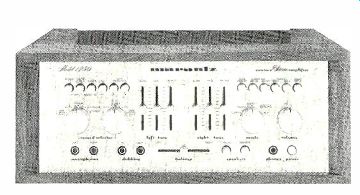
As well as being the most powerful integrated amplifier to bear the Marantz name, the Model 1250 has the distinction of including a unique tape-recording capability unlike any other we have seen. Many amplifiers and deluxe receivers have internal switching for copying from one tape deck to another, and some can dub in either direction. A few can even do this while playing a different program through the loudspeakers. However, with the Marantz Model 1250 it is possible to record a program from one source on one recorder, another program from a different source on the second machine, and still listen to a third program through the speakers! The electrical-performance specifications of the Marantz Model 1250 are equally impressive, if not quite as novel. It is rated to deliver 125 watts per channel to 8 -ohm loads between 20 and 20,000 Hz with less than 0.1 percent total harmonic distortion. We will not attempt to repeat the full list of specifications included in the instruction manual for the amplifier; suffice it to say that they are representative of the finest contemporary amplifier performance.
The Marantz Model 1250 is a rather com pact unit, especially considering its power and versatility. It is only 15 1/4 inches wide x 12 3/4 inches deep x 53A inches high, although it weighs a solid 40.7 pounds. In appearance it resembles the lower-power Marantz amplifiers. The panel is finished in satin gold with matching knobs, pushbuttons, and slider controls. In the center of the panel are six vertical sliders that provide bass, mid -range, and treble tone -control action for the left and right channels. Each slider is lightly detented at eleven positions. Below them is a horizontal BALANCE slider detented at its center.
To the right of the tone controls are the mode selector and volume-control knobs. The former connects the signal channels and the amplifier channels for stereo, reversed stereo, L + R (mono) through both speakers, and either left or right channels through both speakers. Above these knobs are six pushbuttons that affect the amplifier's frequency-response characteristics. The TONE DEFEAT button bypasses the tone-control circuits.
Two TURNOVER buttons change the bass and treble turnover frequencies from their normal 500 and 2,000 Hz to 250 and 4,000 Hz. This makes it possible to modify the response at the frequency extremes (where it is usually needed) without affecting the mid -range. The FILTER buttons introduce 12-dB-per-octave attenuation rates below 30 Hz and above 9,000 Hz. The LOUDNESS button activates the loudness compensation in the volume-control circuit.
At the upper left of the panel are the four input-selector buttons and two tape-monitor buttons for the tape decks connected to the amplifier. The program sources accommodated include PHONO 1, PHONO 2/MIC, TUNER, and AUX. Across the bottom of the panel, from left to right, are the two microphone jacks and two tape DUBBING jacks (each handles both channels, so that one serves as a re cording output and the other as a playback in put) for use with tape decks that are not permanently connected to the system. These jacks disable and replace the rear TAPE 2 circuits when plugs are inserted into them. The two SPEAKERS pushbuttons separately connect two pairs of speakers to the amplifier outputs. Finally, there is a headphone jack and a power pushbutton (a blue pilot light is located in the top center of the panel).
We have saved until last the unique RECORD SELECTOR switch facilities that give the Model 1250 its unparalleled versatility. They are actually separate rotary input -signal selectors for the two tape decks controlled by the Mod el 1250. When both are set to their DIRECT position, the amplifier functions like almost any other, with the program selected by the main input buttons appearing at both tape-recording outputs as well as at the amplifier outputs.
Monitoring (or playback) from either recorder is selected in the usual manner with the tape-monitor buttons. The PHONO position on either record -selector knob connects the corresponding recorder for dubbing from either phono input, depending on which input push button has been depressed. Each record-selector knob also has TUNER and AUX set tings plus a TAPE COPY position. If deck number 1 is set to TAPE COPY, it records the play back from deck number 2, and vice versa. It must be appreciated that unless the recorders are switched to the DIRECT setting, these re cord -selector functions are entirely independent of the input-selector buttons mine the program being heard through the speakers.
In the rear of the Model 1250, together with the inputs and outputs, there are separate PRE-OUT and MAIN IN jacks. These, too, are un conventional in that they are joined without external jumpers or use of a special switch.
Instead, plugging a standard phono plug into one of the MAIN IN jacks disconnects that power-amplifier channel from the preamplifier output and connects it to the new source. Presumably, if one wished to use the Model 1250 as a preamplifier alone, one could insert shorting plugs into the two MAIN IN jacks and take the outputs from the PRE our jacks.
A DIN socket duplicates the functions of each of the groups of tape-recording jacks.
Left- and right-channel SCOPE outputs are supplied for connection to a Marantz tuner having a built-in oscilloscope display (any external oscilloscope could be used, of course).
The spring-loaded speaker -output terminals are designed to receive the stripped ends of the wires, clamping them firmly when the spring is released. As would be expected from an amplifier with such elaborate input facilities, the Marantz Model 1250 has a goodly number of a.c. convenience outlets--six in all, with two of them switched.
Suggested price: $699.95. An optional walnut-veneer cabinet costs $42.50.
Laboratory Measurements. Following the usual one -hour preconditioning period at one third rated power, the outputs of the Marantz Model 1250 clipped at 162 watts per channel into 8 ohms at 1,000 Hz. The outputs for 4 and 16 ohms were, respectively, 242 and 90 watts per channel.
At 1,000 Hz, total harmonic distortion (THD) was 0.005 per cent or less at outputs up to 10 watts, rising slowly to 0.012 per cent at 130 watts and 0.06 per cent at 160 watts just before clipping occurred. The intermodulation distortion (IM) was less than 0.025 per cent from 1 watt to the rated 125 -watt output, reaching 0.058 per cent at 150 watts. It also rose slightly at very low power levels-to 0.19 per cent at 10 milliwatts. At rated output, the THD was essentially less than 0.04 per cent from 20 to 20,000 Hz (approaching 0.01 per cent over much of that range). The distortion did not change significantly at lower power levels.

----45 FREQUENCY IN HZ (CYCLES PER SECOND) CONTINUOUS AND EQUIVALENT SINE
-WAVE WATTS/CHANNEL
The tone -control characteristics had the expected shapes, closely matching Marantz's specifications. Using the 250- and 4,000 -Hz resulted in a flat response between 150 and 5,000 Hz even at the extreme control settings, which changed the output by about ±8 to -±10 dB at the frequency extremes of 20 and 20,000 Hz. The mid range control action was centered at about 900 Hz with a maximum range of ±7.5 dB. Al though it affected a wide range of frequencies (from about 100 to 5,000 Hz), its limited range prevented it from creating a grossly unnatural effect.
The filters had the rated 12-dB-per-octave slopes, and in their effects were as close to ideal as conventional fixed filters can be. The high -frequency cut-off (the -3 -dB point) was at about 8,000 Hz, while the low-frequency cut-off was below 30 Hz. The low filter reduced the output by 12 dB at 15 Hz and by 30 dB at 5 Hz, effectively removing the rumble frequencies found in today's better turntables. The loudness compensation boosted both low and high frequencies. The RIAA equalization error was within the tolerances of our test instruments-less than ±0.25 dB from 50 to 15,000 Hz and, on an extended measurement, within ±0.4 dB from 20 to 20,000 Hz. The equalization was not significantly altered by the inductances of representative phono cartridges; the typical effect on response was a smooth rise with increasing frequency to a maximum of +1 dB at 20,000 Hz.
The Marantz Model 1250 has relatively high gain, requiring only 49 millivolts at a high-level input (or 0.5 millivolt at a phono input) for a reference output of 10 watts. The noise level, referred to 10 watts, was -80 dB through the high-level inputs and -75.5 dB through the phono inputs. This represents excellent low-noise performance since our measurement is unweighted and is made with a normally terminated input instead of the shorted input of ten used. The microphone input had about the same sensitivity as the phono input (0.55 millivolt) with a -67-dB noise level, reflecting the flat microphone -amplifier response in stead of the high -frequency roll -off of the phono circuit's RIAA equalization.
The phono inputs overloaded at 300 millivolts, one of the best figures we have measured and especially noteworthy in view of the amplifier's high gain. The microphone overload was at 360 millivolts, making inadvertent overload and distortion an unlikely possibility. The conservative design approach of the Marantz Model 1250 is perhaps best il lustrated by the fact that its main amplifiers require only a 1.7 -volt input to drive them to the clipping point (1.43 volts for rated output), yet the preamplifier section can deliver 13 volts (rated 10 volts) before it clips! Apart from the huge reserve margin this gives to the amplifier, it means that the power amplifier can be driven by just about any preamplifier or accessory device and that the preamplifier in the Model 1250 can in turn drive just about anything without exceeding its capabilities.
Comment. On the rare occasions when we come across a product as outstanding as the Marantz Model 1250, we make an extra effort (since nothing is perfect) to find a weak spot.
Try as we might, we could not fault the amplifier. No test, either by measurement or by use, revealed any respect in which it fell short of its potential. This may not mean that it is perfect, but it does mean that we couldn't find any limitations.
The operating controls have a smoothness and positive "feel" that are consistent with the image of quality associated with a top-end amplifier from one of the most highly respect ed names in the industry. There are no un wanted noises, switching transients, or the like when anything is pushed or turned. The amplifier's protective relay does not connect the speakers until all turn -on transients have subsided, and it disconnects them first when it is shut off. For all practical purposes it is a noise-free amplifier.
For those who are impressed by transient response and slew-rate performance (we have some reservations about their significance to the listener), we can say that the rise time of the amplifier, including the preamplifier section, is about 1 microsecond and that the slew rate is about 30 volts per microsecond. Clearly there have been no sacrifices in these respects in the design of the Model 1250.
We suspect that the true appeal of the Marantz Model 1250 will be to the advanced tape recordist, who will appreciate its remarkable taping flexibility. The possibility of control ling and using three separate programs simultaneously through the same control amplifier is a little mind -boggling, but it works, and very well. The RECORD SELECTOR controls are so logically marked and designed that their use becomes almost automatic after a brief period of familiarization.
When it is considered that most integrated amplifiers whose electrical performance com pares with that of the Marantz Model 1250 not only lack its complete operating flexibility but are more expensive, it begins to appear that the Marantz Model 1250 is something of a "best buy" for those who are in the market for a powerful, state-of-the-art amplifier that is distinctly different from its competition.
Also see:
TECHNICAL TALK: Class A, B, C, D ...and G Amplifiers, by JULIAN D. HIRSCH
PHONO CARTRIDGES: A short course in cartridge types and specs for the buyer, by JULIAN D. HIRSCH
Source: Stereo Review (USA magazine)